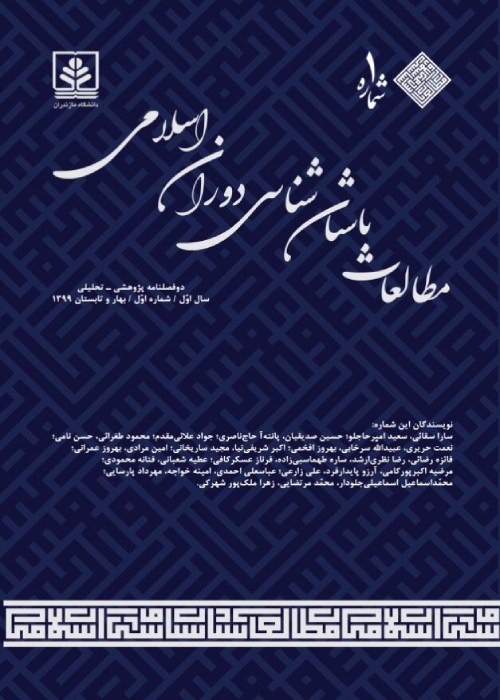Classification and Typology of Plaster Moulding Motifs in Masjed-e Jame Siraf
The remains of the ancient port of Siraf are located in a narrow plain approximately 4.5 km long on the northern shores of the Persian Gulf, about 250 km southeast of Bushehr port. Most geographers and travelers in their mentions the commercial and economic prosperity of this port and indicate it with titles such as the capital of the Sassanid province "Ardeshir Khoreh", the gateway to China and the warehouses of Pars and Khorasan. The first archaeological excavations of Siraf began in 1345 by a joint delegation of English and Iranian archaeologists, led by David Whitehouse and continued until 1352 in seven separate seasons. In 1974, the Archaeological Center of Iran undertook the process of excavation in this area by an archeological team headed by Hossein Bakhtiari. In this series of excavations, the remains of the building of the Masjed-e Jame, which due to the general structure and the period of its construction and development, was among the most significant mosques of the first centuries of the Islamic era of Iran, it was completely excavated. The present study intends to investigate and study the samples obtained from the structure of this mosque and its comparative studies with the plaster-moldings of Masjed-e Jame of Naien, while explaining and separating the themes used in this complex in order to study the effect of this building on the process of transition from the cultural atmosphere of the Sassanid period to the Early Islamic centuries and the formation of Islamic artistic components.
In order to provide the objectives of the present study, after a brief introduction of the Masjed-e Jame Ghadim of Siraf and a general overview of the various architectural dimensions of the building, the motifs used in the discovered structures are described separately and its commonalities and differences with the collection of motifs and the themes used in the plaster-moldings of the Masjed-e Jame of Naein will be considered as the basis of typology and classification. Generally, four plaster-moldings are obtained from the excavations of the Masjed-e Jameh in Trench B, which had physical details to study. The first two examples are plaster-molding blocks which were decorated with plant motifs by molding technique and probably mounted on the exterior of the building, above the porch or walls. The third piece, is a part of the plaster-molding that was probably used to decorate the wall of the mosque by constantly creating the shape of circles that include plant designs such as Lotus. The fourth and last piece mentioned in this research is an inscription written in Kufic inscription which was engraved in three horizontal rows with the technique of deep and embossed bedding. Although, there is a fourth row which is unfortunately not legible due to physical damage and its content is not clear.
Generally, in terms of the type of decorations, the motifs used in the plaster-molding decorations can be divided into three types such as plant motifs, geometric motifs and Kufic inscriptions, which were created using two techniques of mold motifs and deep plastering.The most common geometric pattern in this collection is the circular pattern, which is repeated separately or in combination and includes plant motifs. The comparative analogy of this form shows the continuation of the use of the simple type of this motif, which has its roots in the Sassanid period and has not yet been involved in the structure of the geometric patterns of the Middle and Late Islamic periods. Although, the combined examples of this motif are comparable to the early Islamic examples, but the simplicity lies in it and shows that they are raw and primitive. The plant motifs used in these structures include abstract flowers and leaves mixed with branches. The simplicity and abstraction which is evident in the flowers are comparable with Sassanid examples in Ctesiphon; but this is not the case with the leaves. The inscription in Masjed-e Jame Ghadim of Siraf was written in Iranian Kufic with deep plastering technique.
In general, the geometric patterns used in the plaster-moldings in Siraf are more similar to the Sassanid examples in terms of structure and execution technique, but their slight arrangement can be considered as a manifestation of Islamic teachings. Although, by following the Sassanid pattern, the plant motifs have created a symmetrical composition, but they have become very simple and similar to examples in Islamic collections such as Masjed-e Jame of Naein. The structural composition and decorative details of the single inscription which was discovered from Masjed-e Jame of Siraf are all features that make the inscription comparable to similar examples from the fifth and sixth centuries A.H; however, the non-religious content of the inscription is the reason for its difference from other examples. Although the result of the present study does not determine a specific pattern for the designs and artistic compositions of the studied plaster-moldings, but it creates a general perspective of the origin of the trusted themes and reveals their stylistic tendency. Establishing a connection between the studied motifs and similar Sassanid examples is not an easy task; However, these concepts can be considered influenced by the plaster-moldings of the Sassanid period more than the other examples, and they can be considered as an intermediate link between the plaster-moldings of the Sassanid and the plaster-moldings of mosques of the early Islamic centuries in Iran.
- حق عضویت دریافتی صرف حمایت از نشریات عضو و نگهداری، تکمیل و توسعه مگیران میشود.
- پرداخت حق اشتراک و دانلود مقالات اجازه بازنشر آن در سایر رسانههای چاپی و دیجیتال را به کاربر نمیدهد.



